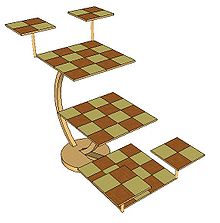3D chess
The term 3D chess ( three-dimensional chess) includes all chess variants that add a coordinate axis to “normal” ( two-dimensional ) chess . In addition to the different number and arrangement of the fields, there are also different sets of rules for most 3D chess games.
Room chess
The idea for three-dimensional chess is relatively old. The Baltic chess master and former mathematics teacher Lionel Kieseritzky constructed a "room chess" in the middle of the 19th century, but, as a description of the then leading German chess player Adolf Anderssen suggests, met with disinterest or amusement. Anderssen's eyewitness report ("where I saw an object hanging that was similar in content and form to a birdcage ") is an early testimony to the construction problems that make it difficult to implement the spatial chess concept.
One of the oldest 3D chess variants is room chess (originally " chess room game "), which was developed in 1907 by Ferdinand Maack , a doctor and author of esoteric works. After initially experimenting with eight board levels, Maack decided on a more easily playable “cube” with five boards, each with 5 × 5 fields, one on top of the other. He also recommended introducing a special room chess piece, the unicorn . It moves on the room diagonals analogous to the bishop in two-dimensional chess.
Werner Bäumler (artist name Laurin ) developed a further development towards 8 × 8 × 8 . In contrast to Maack's room chess version, the rules strive for the most exact transformation of the area chess into space. The game developer Waldemar Zöllmer presented a similar set of rules in 2005. With this construction, instead of playing fields lying on top of each other, the figures are hung on nylon threads in order to create greater game transparency and to be able to see all 512 fields at a glance.
Star Trek Chess
Another well-known 3D chess variant is the one that was first used in the 1965 second pilot for the Star Trek television series " Raumschiff Enterprise ". Because of its origins, this game is also known as Star Trek Chess .
There are no official rules for Star Trek chess. Individual trailers therefore created different sets of rules. The "Standard Rules, Version 1.0 by Andrew Bartmess" are among the oldest rules. There are various German translations of these rules, some of which are contradictory. The most common translation on the Internet is by Martin Vorlaender. In the meantime, however, there is version 5.0 of these rules, some of which are fundamentally different from the original version.
A more detailed, different set of rules for Star Trek chess are the "Tournament rules of Jens Meder, Michael Klein and others", which are based on the FIDE rules of the World Chess Federation . Douglas M. Keenan now also has a 3D chess program for Windows called Parmen . You can play against each other as well as against a computer opponent. Parmen offers two different rule variants: One is similar to the rules of Andrew Bartmess, the other is based on the "tournament rules of Jens Meder". We are still working on a full implementation of the tournament rules.
Other variants
In addition to the 3D chess variants presented above, there is an almost inexhaustible fund to draw on. It is hardly possible to describe all variants in detail. Often, special new figures were developed. The most obvious are and will remain the differences that are caused by the various 3D chess boards.
The cube-shaped chess games such as the room chess by Maack (5 × 5 × 5) or a transfer to eight board levels form a large group . Solutions with 4 × 4 × 4 and 6 × 6 × 6 are also enjoying a certain popularity. In addition to the chess variants in cube form, there are also games in which the number of boards does not correspond to the number of lines and rows. The most popular representative in this category is likely to be 8 × 8 × 3 chess . Finally, the pyramid chess games should be mentioned here , in which the boards get smaller and smaller until finally there is only one space left.
See also
literature
- Ferdinand Maack : The chess room game. (Three-dimensional chess game.) A new, practically interesting and theoretically important extension of the two-dimensional chess board game . A. Stein, Potsdam 1907
Web links
- Ferdinand Maack's "Room Chess" (English)
- 8 × 8 × 8 chess by Björn Karlson, Ralph Puchta, Steffen Herrmann ( Memento from August 1, 2015 in the Internet Archive )
- "Laurin's room chess"
Individual evidence
- ↑ Quoted from Emil Schallopp : The Chess Congress in Leipzig 1877 . Berlin 1878 (reprinted Zurich 1990), p. 5f.
- ^ Otto Borik , Joachim Petzold : Meyers Schachlexikon . Meyers Lexikonverlag, Mannheim 1993, p. 219 (entry "Raumschach"). ISBN 3411088117
- ↑ Andrew Bart Mess: The Federation Standard Tri-D Chess Rules (Rev. 5.0) . 2005.
- "Star Trek Chess":
- ↑ TriSchach by Andrew Bartmess translated by Martin Vorlaender 1977 ( Memento from August 16, 2009 in the Internet Archive )
- ↑ Michael Klein's 3D chess page
- ^ 3D chess page by Jens Meder


